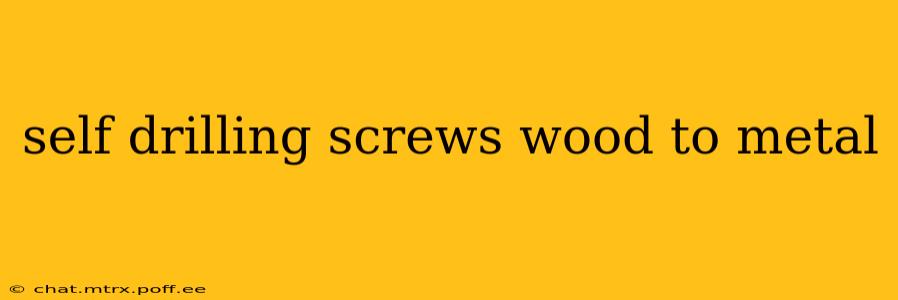Self-drilling screws are a handy solution for joining wood to metal, offering a faster and often simpler alternative to pre-drilling. However, selecting the right screw and employing the correct technique is crucial for a strong, lasting bond. This guide explores the specifics of using self-drilling screws for wood-to-metal applications, addressing common questions and providing expert advice.
What are Self-Drilling Screws?
Self-drilling screws are designed with a pointed tip and cutting threads that allow them to penetrate materials without the need for pre-drilling. The pointed tip pierces the material, and the cutting threads create their own pilot hole as they are driven in. This makes them particularly useful for fast assembly and applications where pre-drilling is difficult or impossible. Different types exist, optimized for various material combinations, including those specifically designed for wood-to-metal applications.
What Kind of Self-Drilling Screws Should I Use for Wood to Metal?
The best self-drilling screw for wood-to-metal applications will depend on the thickness of the wood and metal, as well as the desired holding power. Look for screws specifically marketed for this purpose. They often feature a drill point designed to penetrate both wood and metal effectively. Consider these factors:
- Screw Material: Screws made of hardened steel or stainless steel offer superior strength and corrosion resistance, particularly important in outdoor applications.
- Screw Thread Type: Coarse threads provide better grip in softer woods, while fine threads offer greater precision and holding power in harder woods and thinner metals.
- Screw Length: Ensure the screw is long enough to penetrate both the wood and the metal sufficiently, leaving adequate thread engagement in both materials. A general rule is to have at least two-thirds of the screw's length embedded in the thicker material.
- Screw Head Type: The head type (e.g., pan head, countersunk, oval head) will depend on aesthetic preference and the desired finish.
How Do I Use Self-Drilling Screws to Attach Wood to Metal?
While self-drilling screws simplify the process, proper technique ensures a secure and lasting joint.
-
Pilot Hole (Sometimes): While self-drilling screws are designed to create their own holes, pre-drilling a small pilot hole in the wood (especially thicker pieces) can prevent splitting, particularly in hardwoods. This is especially true for screws with larger diameters.
-
Surface Preparation: Ensure both the wood and metal surfaces are clean and free from dirt, grease, or rust. This improves screw penetration and grip.
-
Screw Alignment: Carefully align the screw and apply even pressure as you drive it in. Using a power screwdriver is recommended for consistent torque and to prevent stripping the screw head.
-
Torque Control: Avoid over-tightening, which can strip the screw or damage the materials. Use a torque setting appropriate for the screw size and the materials involved.
-
Countersinking (Optional): For a flush or countersunk finish, use a countersinking bit before driving in the screw.
What are the Advantages of Using Self-Drilling Screws for Wood to Metal Joints?
- Speed and Efficiency: The self-drilling feature eliminates the need for pre-drilling, saving significant time and effort.
- Simplicity: It's a relatively straightforward process requiring minimal tools.
- Cost-Effectiveness: It can reduce labor costs compared to pre-drilling and other fastening methods.
What are the Disadvantages of Using Self-Drilling Screws for Wood to Metal Joints?
- Potential for Material Damage: Over-tightening or using inappropriate screws can lead to wood splitting or metal deformation.
- Limited Holding Power (Compared to Other Methods): In some high-stress applications, other fastening methods may provide superior holding strength.
- Not Suitable for All Materials: The suitability depends on the thickness and type of materials.
Are Self-Drilling Screws Stronger Than Other Wood to Metal Fasteners?
Self-drilling screws offer a good balance of strength and ease of use for many wood-to-metal applications. However, they might not be the strongest option in all cases. Other fastening methods like bolts and rivets can provide superior strength in high-stress applications or when joining thicker materials. The best choice depends on the specific demands of the project.
Can I Use Self-Drilling Screws for Outdoor Applications?
Using stainless steel self-drilling screws is recommended for outdoor projects to resist corrosion. Ensure that the materials are suitable for outdoor exposure as well.
This guide provides a comprehensive overview of using self-drilling screws to join wood to metal. Remember to always select the appropriate screw type and employ the correct technique to ensure a secure and long-lasting connection. Consult relevant manufacturers' guidelines for specific screw types and applications.
